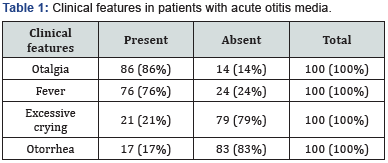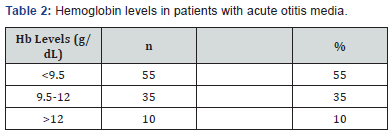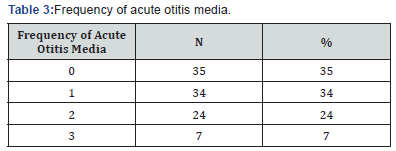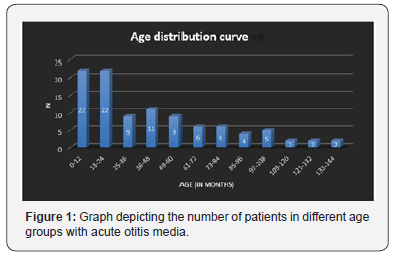Journal of Otolaryngology Juniper Publishers
Authored by Haritosh K Velankar*
Abstract
Objective: This study was designed to examine the co-incidence of acute otitis media and iron deficiency anemia in children below 12 years of age, and to evaluate the effect of restoring normal hemoglobin levels on the occurrence of attacks of acute otitis media.
Materials and methods: A prospective study was conducted in a single tertiary center over a period of two years. A total of 100 children who were diagnosed with acute otitis media by otoscopic examination underwent evaluation of complete blood count and serum ferritin levels in their blood. The number of episodes of acute otitis media was recorded on follow-up. A statistically significant correlation between the iron deficiency anemia and episodes of otitis media was established.
Results: In these 100 children, the episodes of acute otitis media pretreatment average were 1.01±0.91 whereas post treatment was 0.20±0.40. The average hemoglobin concentration before treatment was 9.624±1.71. Fifty five percent of the children had hemoglobin levels less than 9.5g/dL. It was observed that the frequency of acute otitis media was reduced by correction of iron deficiency anemia.
Conclusion: It was concluded that iron deficiency anemia increases the susceptibility of children for recurrent episodes of ear infections and that it might be considered as a potential risk factor for such a common disease in infancy and childhood. Therefore, it is recommended to evaluate the hemoglobin level in every child who is diagnosed with episodes of acute otitis media. Correction of iron deficiency anemia proves to be an effective additional line of treatment for acute otitis media.
Keywords: Acute otitis media; Iron deficiency anemia in childhood; Hemoglobin.
Introduction
Acute otitis media is one of the most commonly occurring inflammatory diseases of infancy and childhood. Eighty five percent of children experience at least one episode of otitis media, and the most frequent indication for prescription of antibiotics or surgical therapy in this age group [1]. It is also a leading cause of hearing loss in children and it is fair to say that this disorder is most important, unresolved clinical problems in otolaryngology (Table 1). It affects 20-30% of the pediatric population. The upper respiratory tract is an obvious portal of entry for microorganisms and an adequately functioning immune system is required to prevent the establishment of infections in the ear, nose, and throat [2]. Anemia is defined as a reduction of the hemoglobin concentration and red cell volume compared to age- matched values. The average hemoglobin level in children between 6 months and 48 months is 12.0g/dL (10.5g/dL to 14.0g/dL). Anemia in childhood is mainly caused by iron deficiency and it is prevalent in developing countries and among lower socio-economic groups in the western world [3]. Both iron deficiency and overload has negative effects on immune function; a balanced iron homeostasis is central to determining susceptibility toward and the fate of an infection.

Several investigators demonstrated that two abnormalities in the immune system are associated with iron deficiency in humans- an impaired response of T cell lymphocytes to mitogens, and a decreased bactericidal activity of neutrophils [4]. There is a prevailing opinion among pediatricians that infants and children who have moderate to severe anemia tend to have more infections than those who do not (Figure 1). On the other hand, there are also few studies which showed that iron deficiency state may be protective and may even increase the resistance to bacterial infection as it creates an unfavorable condition for the potential infective agents which will have a difficulty in obtaining the iron required for their metabolism, more over iron overload may actually predispose an individual to infection [4,5]. Because of the conflicting opinions about the role of iron deficiency anemia plays in increasing or decreasing susceptibility of an individual to infection, and otitis media being one of the most common bacterial infection in children came the importance to conduct this study to investigate the presence of any relationship between iron deficiency anemia and the occurrence of episodes of acute otitis media (Table 2). Establishing this relationship can be of diagnostic and prognostic value as it might be helpful to evaluate the effect of restoring normal hemoglobin levels on the frequency of acute otitis media episodes.

Materials and Methods
The aim and objective of this study is to determine the coincidence between acute otitis media and iron deficiency anemia in children below 12 years of age. This prospective type of clinical study was carried out on pediatric patients attending the ENT outpatient department of our tertiary care center between 2015 and 2017. A total of 100 patients of age 12 years and below and both sexes suffering from acute ear infections were selected for study (Figure 2).

Inclusion criteria
a) Patients of age 12 years and below and both sexes with acute ear infections.
b) Patients with otoscopic features of acute otitis media.
c) Patients with recurrent episodes of ear infections.
Exclusion criteria
a) Patients above 12 years of age.
b) Patients with chronic otitis media/ those who underwent ventilation tube placement.
c) Patients with cleft lips and/or cleft palate.
d) Immuno-compromised patients (diabetic, chemotherapy and radiotherapy, renal and hepatic failure).
e) Patients with congenital anemia, malabsorption or other gastrointestinal diseases.
f) Patients who received iron supplementation routinely.


Patients who fulfilled the inclusion criteria were studied and evaluated. A detailed history was taken and general physical examination with neurological and complete otorhinolaryngological examination was conducted (Table 3). Diagnosis of acute otitis media was confirmed by otoscopy. Ear swab culture and sensitivity was done when patient presented with ear discharge. Peripheral venous blood samples for complete blood count and serum ferritin levels from all patients were taken (Figure 3). All iron deficient anemic children were managed through oral iron supplements under full supervisor and guidance. In this study the anemic children were treated with once daily dose of oral Vitcofer syrup (ferrous ascorbate 30 mg + folic acid 0.5mg /5ml). Patients were followed up in six months of iron supplementation with fresh complete blood count profile. This study was approved by the local institutional review board, and an informed consent form was signed by the parents of the children. The data were checked, entered, and analyzed using SPSS (SPSS Inc., Chicago, IL). Results were expressed as mean±standard deviation for quantitative variables, and as number and percentage for qualitative ones. P values ≤0.05 qualify as significant results and those ≤0.001 as highly significant results.
Results
It was observed that the maximum number of patients belonged to age group 0-12 and 12-24 months. The mean±standard deviation of age was 44.92±36.14 months with a range of 6 to 144 months of age. Out of 100 patients, 52% (n=52) patients were male and 48% (n=48) patients were females. Among the symptoms experienced by the children, 86% had otalgia, 76% had fever, 21% had excessive crying and 17% had otorrhea. 47% patients had sterile ear swab culture sensitivity (Table 4). Pallor was observed in 69% of the patients and 31% did not have pallor clinically. We found that 55% of the children who presented with acute otitis media had hemoglobin levels <9.5g/dL whereas 10 % of the children had hemoglobin level >12g/dL. The mean hemoglobin concentration pretreatment was 9.624±1.71 with 55% of the children having hemoglobin less than 9.5g/dL. Post treatment the mean hemoglobin concentration was 11.86±1.02. Thirty five percent of patients had no recurrent episode of acute otitis media, whereas seven percent of patients had 3 episodes of acute otitis media post treatment with iron supplementation. The episodes of acute otitis media pretreatment (6 months) was 1.01±0.91 and post treatment was 0.20±0.40 (6 months) and it was found to be statistically significant p=0.002.

Discussion
There have been conflicting studies showing the relationship between acute otitis media and iron deficiency anemia [1,2,4,5]. The purpose behind this study was to establish a connection between iron deficiency anemia and the occurrence of acute otitis media. Acute otitis media is a major health concern in children and is a leading cause of physician visits and antibiotic intake in developed and developing countries. It is a multifactorial disease. It seems that the susceptibility to this disease has a genetic background, even though it is an infectious disease that is influenced by various environmental factors [1,2]. Our study showed that the maximum number of patients belonged to age group 0-12 and 12-24 months even though our sample size was small. This observation is similar to the finding found in the Early Childhood. Study longitudinal study of more than 8000 children which showed that otitis media was diagnosed in 39% of children by 9 months and 62% of children by 2 years of age. In most of the studies, the peak incidence of acute otitis media was during the first 6 to 12 months of life6. The incidence decreases with age, and by the age of 7 years, few children experience episodes of acute otitis media. Our study showed a predominance of acute otitis media in male gender like Stentor’s data, in which 61% of the otitis prone group was male children and 35% female, while other studies could find no sex differences. The reasons for this sex predominance are not well known [6,7]. In our study, otalgia was the most commonest symptom (86%) followed by fever (76%), excessive crying (21%) and otorrhea (17%).In studies conducted by conducted by Laine M et al. [8] and Uhari M et al. [9] it is seen that ear pain does not predict acute otitis media in children at the otitis- prone age, but ear pain is an indication for otoscopic examination of children with respiratory tract infections.
Fever has been an indication of acute otitis media in study conducted by Heikkinen Tetal [10] However, other studies have shown no association between them [8,9,11]. In our study maximum patients (47%) presented with sterile ear swab culture sensitivity. This may be due to the prior intervention of antibiotics. Experimental evidence in the last decades shows that iron is a fundamental element for normal development of the immune system. Its deficiency affects the capacity to have an adequate immune response. The role of iron in immunity is necessary for immune cell proliferation12. Many studies have identified several risk factors for otitis media. Anemia was never considered one among them. There are a very few studies on the association of acute otitis media and anemia especially in children below 12 years of age. Our study found that that mean hemoglobin concentration pretreatment was 9.624±1.71. Anemia has been reported as a significant finding in children with acute otitis media. In a study by Deeksha et al they observed that majority (36.1%) of the children was suffering from moderate anemia, and prevalence of severe anemia among children was 7.8%. The prevalence of severe anemia was highest among children (both boys and girls) in the age category 13-18 months [12]. We could not establish a relationship between the degree of anemia and the frequency of episodes of acute otitis media as the duration of the study and the sample size was less. We have shown in this study that the frequency of episodes of acute otitis media before treatment with iron supplementation was found to be 1.01±0.91 while it had significantly reduced after treatment of anemia (p=0.002). A high frequency of such episodes was found to be associated with hemoglobin levels below <9.5g/dL in 55% of the children. The current study showed a relatively low incidence of acute otitis media among children with corrected anemia. It also indicated that apart from infectious causes, other environmental risk factors may have participated in the occurrence of acute otitis media in our community.
Conclusion
Iron deficiency anemia needs to be ruled out in children presenting with acute otitis media. Treatment of iron deficiency anemia by iron supplementation is an essential factor to reduce the occurrence of acute otitis media in children and it can be considered as a supplementary line of medical management.
Acknowledgement
The authors wish to acknowledge all the Doctors and Nursing staff of The Department of ENT who participated in the treatment of these patients.
https://juniperpublishers.com/gjo/index.php





No comments:
Post a Comment